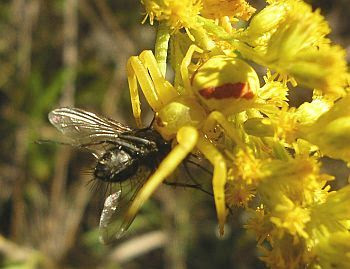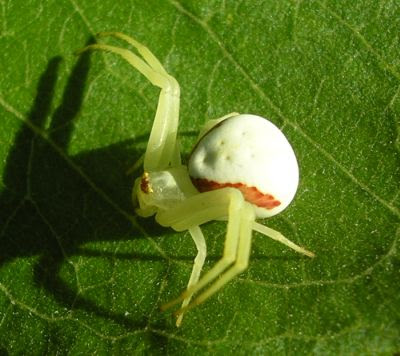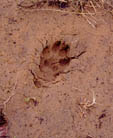
Next month the circus will appear at The Annotated Budak.
Thomasburg is a small hamlet in the Municipality of Tweed in eastern Ontario. Behind my home here is a fallow field, swamp, cedar bush, old apple orchard and woods. Almost every day I take the same walk through this territory to see who's been by, and try to figure out what they've been up to.

The Flickr photo pool continues to grow, along with Bev’s Pbase gallery. Blogger-participants so far include:Windywillow (Ireland)Dave at via negativa will be continuing to update the list on this post as new reports come in--so check in there. Also see his first IRFD post here.Heraclitean Fire (London, England)
Sheep Days (Illinois, USA)
Earth, Wind & Water (somewhere in the Caribbean)
Pocahontas County Fare (West Virginia, USA)
chatoyance (Austin, Texas)
Fragments from Floyd (Virginia, USA) - GRAND PRIZE WINNER
Watermark (Montana, USA)
pohanginapete (Aotearoa/New Zealand)
Fate, Felicity, or Fluke (Oregon, USA)
Thomasburg Walks (Ontario, Canada)
Idle Thoughts of an Idle Woman (Queensland, Australia)
The Transplantable Rose (Austin, Texas)
Nature Woman (New York State, USA)
Marja-Leena Rathje (British Columbia, Canada)
A Blog Around the Clock (North Carolina, USA)
Busy Dingbat’s Sphere (West Virginia, USA)
Hoarded Ordinaries (New Hampshire, USA)
Congo Days (Kinshasa, Congo)
this too (London, England)
Roundrock Journal (Missouri, USA)
Wanderin’ Weeta (British Columbia, Canada)
Blaugustine (London, England)
A Honey of an Anklet (Virginia, USA)
Looking Up (Ohio, USA)
Ontario Wanderer (Ontario, Canada)
Bug Safari (California, USA)
Riverside Rambles (Missouri, USA)
Pure Florida (Florida, USA)
Burning Silo (Ontario, Canada)
More links, added Tuesday, September 4:
Musings from Myopia (Texas, USA)
Cicero Sings (British Columbia, Canada)
Joan (Missouri, USA)
Nature Remains (Kentucky, USA)
prairie point (north Texas)Still more, September, 5:
Cephalopodcast.com (Florida, USA) - VIDEO
Walking Prescott (Prescott, Arizona)
 The day started well. I was out in the yard looking for the noisy Blue Jay family I could hear in the elms when I saw some other birds flitting to and fro--turned out to be a couple of Scarlet Tanagers in winter plumage, or young of the year or both. Not entirely unknown in the yard during the migration, but always a pleasure to see them. I moved down the lawn watching them and listening to a Pileated Woodpecker who had started to call. Then the Woodpecker flew by me heading east, followed almost immediately by a rabbit running in the other direction. Meantime a couple of warblers (of the confusing fall variety) turned up in the Maple by the house, and then I remembered: Today is International Rock-flipping Day!
The day started well. I was out in the yard looking for the noisy Blue Jay family I could hear in the elms when I saw some other birds flitting to and fro--turned out to be a couple of Scarlet Tanagers in winter plumage, or young of the year or both. Not entirely unknown in the yard during the migration, but always a pleasure to see them. I moved down the lawn watching them and listening to a Pileated Woodpecker who had started to call. Then the Woodpecker flew by me heading east, followed almost immediately by a rabbit running in the other direction. Meantime a couple of warblers (of the confusing fall variety) turned up in the Maple by the house, and then I remembered: Today is International Rock-flipping Day! I took this picture of it, as they do on CSI, document the scene before disturbing it. Then, as I bent down to move it, I noticed that it was not alone.
I took this picture of it, as they do on CSI, document the scene before disturbing it. Then, as I bent down to move it, I noticed that it was not alone.  On a very small milkweed plant leaning over the right-hand side of the rock there was quite a substantial Monarch caterpillar munching away. So, another photo, and then I moved on: on to the cedar bush.
On a very small milkweed plant leaning over the right-hand side of the rock there was quite a substantial Monarch caterpillar munching away. So, another photo, and then I moved on: on to the cedar bush. The margins of the spring stream were completely covered up. So I moved into the cedar bush to look for a prospect there. And found this can--in front of a rock, which as you can probably tell was a little too big for flipping without a backhoe. I looked under the can, but found nothing.
The margins of the spring stream were completely covered up. So I moved into the cedar bush to look for a prospect there. And found this can--in front of a rock, which as you can probably tell was a little too big for flipping without a backhoe. I looked under the can, but found nothing. Now this was an interesting rock. It was in the sun and the area around it was relatively dry, but this rock was wet. I could tell that it had been in this spot for sometime when I looked underneath it, but I couldn't help thinking that someone or something had just turned this rock over and left it in place upside down....Who? Why? Underneath it there was a very large cricket that fled immediately and a colony of very shiny, small black ants, including one winged one. Ants are the invertebrates found most often under the rocks around here. I know a little something now about moths and butterflies, I know some of the spider families and a few species, I even know a few true bugs, and other insects, but of ants all I know is that there are many, many species represented around here and I don't know the names of any of them. Under any rock I might see a species I've never seen before, as was the case here, I believe. Still, it was good to finally find a happening rock.
Now this was an interesting rock. It was in the sun and the area around it was relatively dry, but this rock was wet. I could tell that it had been in this spot for sometime when I looked underneath it, but I couldn't help thinking that someone or something had just turned this rock over and left it in place upside down....Who? Why? Underneath it there was a very large cricket that fled immediately and a colony of very shiny, small black ants, including one winged one. Ants are the invertebrates found most often under the rocks around here. I know a little something now about moths and butterflies, I know some of the spider families and a few species, I even know a few true bugs, and other insects, but of ants all I know is that there are many, many species represented around here and I don't know the names of any of them. Under any rock I might see a species I've never seen before, as was the case here, I believe. Still, it was good to finally find a happening rock.
 them for flower crab spiders. Of course I found one, not Misumena vatia, but a crab spider nonetheless. You can see it just going over the edge, being camera shy.
them for flower crab spiders. Of course I found one, not Misumena vatia, but a crab spider nonetheless. You can see it just going over the edge, being camera shy. again, so I photographed it and left it, capturing one of the more interesting of the yellow butterflies that were so numerous this morning; there were maybe three quite similar species flitting around, too quickly to get a fix on.
again, so I photographed it and left it, capturing one of the more interesting of the yellow butterflies that were so numerous this morning; there were maybe three quite similar species flitting around, too quickly to get a fix on. attention to include more of the features of the land. In short, it was a good time. Thanks to Dave for proposing it. And watch here for a list of links to the other participants in the event we call International Rock-flipping day!
attention to include more of the features of the land. In short, it was a good time. Thanks to Dave for proposing it. And watch here for a list of links to the other participants in the event we call International Rock-flipping day!a day for everybody to go outside — go as far as you have to — and flip over a rock (or two, or three). We could bring our cameras and take photos, film, sketch, paint, or write descriptions of whatever we find. It could be fun for the whole family!I've spent so much time this year looking into flowers for spiders, looking at butterflies, looking into foliage for caterpillars and yet I haven't looked under a rock even once. So I'll be there, September 2, looking under some rocks. And apparently there is even a prize being offered:
The grand prize goes to anyone who can get a picture of a non-human critter, such as a bear or a raccoon, flipping a rock on September 2. (I don’t know what the grand prize will be yet, but trust me, it’ll be good.)




 Vireos of all kinds pass through here regularly in the spring, and the fall often brings one or two to the yard, but this year was different. I noticed in the spring that I was hearing a Red-eyed sing rather more than I was used to, day after day, on and on. And call too, that strange scree. (There were days that I thought I'd go mad.) Gradually I realized that there was a nesting pair here. And then I noticed that there was another pair--two nesting pairs where I'd never seen even one before. The Red-eyed vireo is a very common denizen of mixed and deciduous forests (in this range), but what was it doing here, in this yard?
Vireos of all kinds pass through here regularly in the spring, and the fall often brings one or two to the yard, but this year was different. I noticed in the spring that I was hearing a Red-eyed sing rather more than I was used to, day after day, on and on. And call too, that strange scree. (There were days that I thought I'd go mad.) Gradually I realized that there was a nesting pair here. And then I noticed that there was another pair--two nesting pairs where I'd never seen even one before. The Red-eyed vireo is a very common denizen of mixed and deciduous forests (in this range), but what was it doing here, in this yard?




 g from the searchers--look for American Dagger Moth
g from the searchers--look for American Dagger Moth  caterpillars. I've actually only seen one so far this year, but elsewhere in North America these caterpillars must be legion--or at least touching peoples' lives in a whole new way. I've had a couple of recent requests for info on the post--and have responded by email as best I could. No, not poisonous. And, I don't know what can be done for an injured caterpillar but let nature take its course. Meantime, enjoy a jigsaw puzzle: Dagger Moth Caterpillar Jigsaw Puzzle.
caterpillars. I've actually only seen one so far this year, but elsewhere in North America these caterpillars must be legion--or at least touching peoples' lives in a whole new way. I've had a couple of recent requests for info on the post--and have responded by email as best I could. No, not poisonous. And, I don't know what can be done for an injured caterpillar but let nature take its course. Meantime, enjoy a jigsaw puzzle: Dagger Moth Caterpillar Jigsaw Puzzle.










Milkweeds are an important component of the native and naturalized vegetation communities of Ontario as they are an important nectaring plant for many species of Lepidoptera, such as the Monarch butterfly. (From Milkweed Species in Ontario)
Why is Milkweed on the List of Noxious Weeds in Ontario?
Common milkweed can be a very difficult weed to control in many field crops thereby causing significant reductions in crop yield and quality. This can have a considerable negative impact to a grower's net economic return. In the last 10 years, new herbicide technologies have greatly improved the control of common milkweed in field crops. However control of common milkweed around field borders is essential as it minimizes seed spread into fields and therefore reduces the reliance on herbicides for "in field" control.
Common milkweed when consumed in large quantities is poisonous to livestock. Therefore minimizing populations in actively pastured land will greatly reduce the chance of any adverse health affects to livestock.
For more information on Milkweed and the Weed Control Act, refer to the article entitled: "Milkweed Species in Ontario".
Protection: There is no formal protection for this species in Ontario. Three key management strategies have been identified to protect the Monarch Butterfly. Milkweeds, the larval foodplant, should be taken out of the noxious weed acts in Canada; native wildflower habitat should be protected and encouraged; and migration stopover sites should be protected from disturbance.







Believe it or not, the next edition of I and the Bird is our second anniversary! Since the first I and the Bird back in July 2005, the nature blogosphere has burgeoned, blossomed, and bloomed. Today, hundreds of impassioned authors write about wild birds and birding, straining the capacity of even the fastest web surfer. Because there are just so many amazing nature blogs out there and just not enough time to frequent more than a fraction of them, I'm adding a twist to our anniversary edition of IATB. When you submit your contribution to me [by July 10], our next host, I'd like you to also sell your blog to readers with a brief but pointed summary of what your blog is about. This tagline, slogan, or teaser should be 20 words or fewer, something like "The best darn birding blog on the planet Earth" or "Monitoring the avifauna of Oshkosh so you don't have to" or even "Birding, blogging, bombast" though that last one clearly needs work...






I got a bird that whistles,
I got a bird that sings.
I got a bird that whistles,
I got a bird that sings.
But I ain' a-got Corrina,
Life don't mean a thing.





